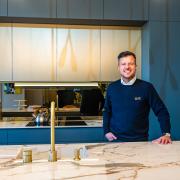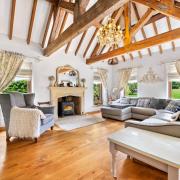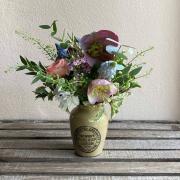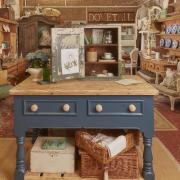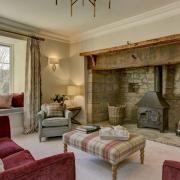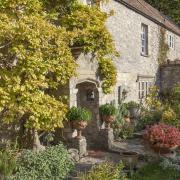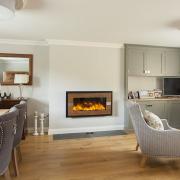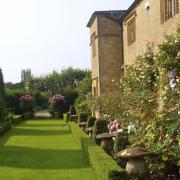To visit Midelney Manor is to get some idea of how Somerset was in Saxon times when King Alfred hid in the marshlands, evading the Danes, says Victoria Jenkins

Whenever there are floods on the Levels, Midelney Manor becomes an island again, just as it always was in Alfred’s time when it and its sister islands Thorney and Muchelney were surrounded by an inland sea.
“The only way you could reach them was by boat or by rather perilous causeways,” says Alice Acton who inherited the
Grade I listed Midelney Manor eight years ago. “But the first record we have of Midelney is even earlier, in 700, when King Ina of the West Saxons granted a charter of land to the Abbots of Muchelney. The Abbots were still here in the early middle ages as we know they used Midelney as a summer retreat with a deer park.”
In fact the abbots lasted all the way up to the Dissolution of the Monasteries, which began in 1536.

However Alice’s family, the Cely Trevilians, have been at Midelney Manor almost as long as the abbots were at Muchelney.
“In the 1400s the Trevilians came up from Cornwall to became stewards to the abbots,” says Alice. “We believe their hunting lodge was where our manor now is but, just before the Dissolution, brothers Thomas and Richard Trevilian realised what was about to happen. So they demolished the hunting lodge and built themselves a manor house on top of it, completed in 1542. We know that under one of our hearths there are the remains of an old Saxon fireplace.”
It seems the brothers had fallen out with each other so they built two separate houses – but joined together – and distinguished by their different types of roof tile.
Alice first saw her romantic home when she was just 13 and her father had moved the family down from Scotland. “My grandparents then moved into one half of the manor, the part we call Midelney East and we moved into the other half, Midelney Manor. Together they form a beautiful Tudor manor house with its rare Grade I listing.”
There is also a granary, a farmhouse and two cottages plus extensive and wonderful gardens with names like the Walled Garden, the Warwick Garden and the Bowling Green, all set in 400 acres of land; also a rare 18th¬century falcon mews.
Alice enjoyed five years at the Manor before going to work in London and never properly lived there again until she had been married for five years to Jeremy Acton and had three children, Harry, now 11, Sam, 10, and Rose, nine.
But then sadly her father died, her mother moved into Midelney West and Alice and family came back to live in her childhood home, Midelney Manor.
Naturally enough such an ancient house, with just the one family having lived there for 500 years, has its share of ghosts.
“When we first moved here from Scotland my parents would hear – at exactly 8pm each evening – footsteps crossing the Elizabeth Room and then back again,” says Alice. “They would turn the TV up so I wasn’t aware of it. It went on for a month. Then when my grandfather died it happened again – and then again when I moved back in with Jeremy and the children.”
The Elizabeth Room is named after Elizabeth Jennings who married a John Trevilian in the 1700s. He had the unfortunate habit of disappearing to London with the rent money and only returning once it was spent.
Alice has also heard footsteps in the passage outside her bedroom and says that when she and her family first moved back she would wake at 2am to hear the little brass covers on the keyholes rattling on each door all the way down the passage.
“But I know it has to be one of my ancestors so I don’t find any of it frightening,” she says. “Our home is not in the least bit creepy and has a very happy feeling about it.”
One very attractive room is the Van Wyck Room, named after the Dutch baroque painter Jan Wyck (“Yes, I know we’ve somehow changed the name,” says Alice). This is because a picture above the mantelpiece was by a travelling artist, a follower of Jan Wyck who lived from 1652¬1702 and worked in England for most of his life. “A travelling artist would sing for his supper by painting a scene for the family with whom he stayed,” says Alice. “Our picture is 17th century and depicts John Trevilian hunting his hounds on a Sunday with Midelney Manor in the background. This would have been considered quite shocking as John was a churchwarden. This is why the devil is painted on the right hand side in a tree smoking a church warden’s pipe!”
Recently the family has launched a new venture – hiring out their beautiful house, gardens and some of the buildings as a wedding venue.
“It’s a very romantic place to hold a reception,” Alice adds.
“Wedding parties can have a marquee or use the quirky Potting Shed which seats 80 people. But these facilities are available for any sort of celebration, not just weddings. And I hope that will remain the case for another 500 years.”
Want to have peek through the keyhole of more stunning Somerset properties? Take a look at...
Through the keyhole: Modern coach life




